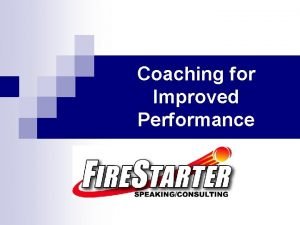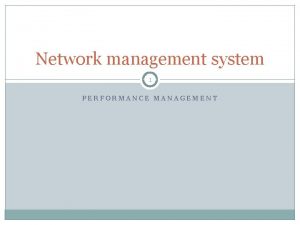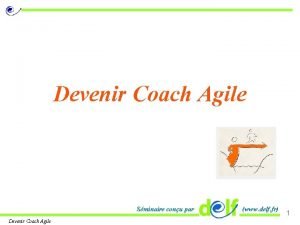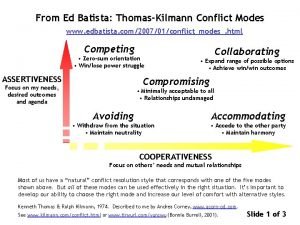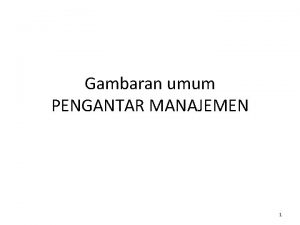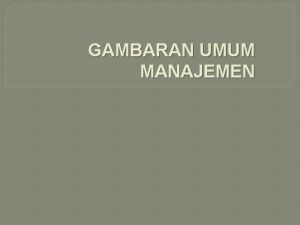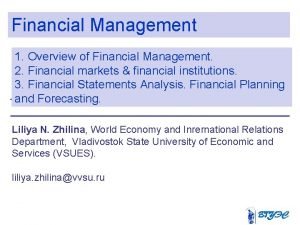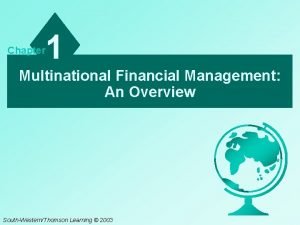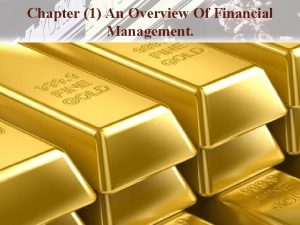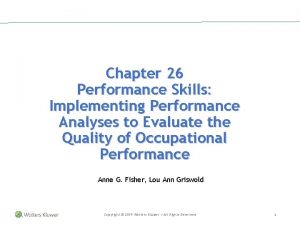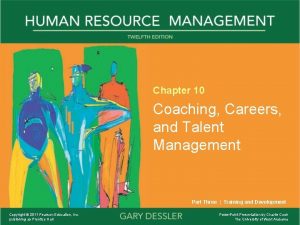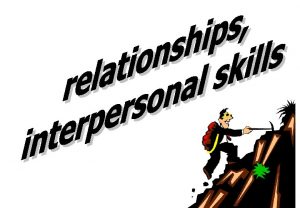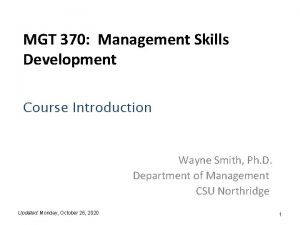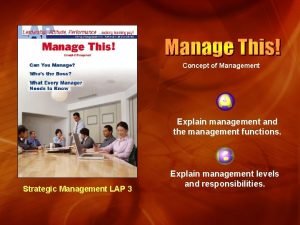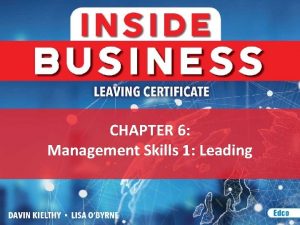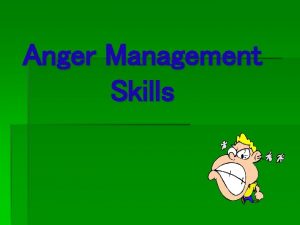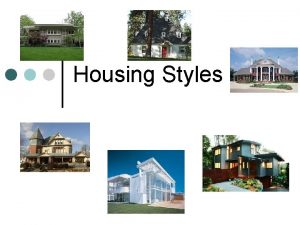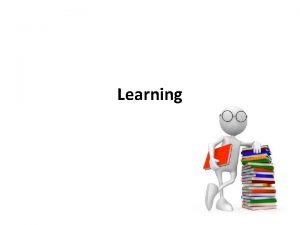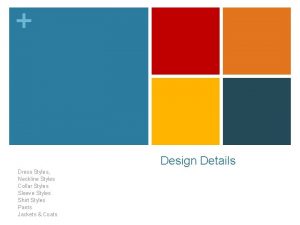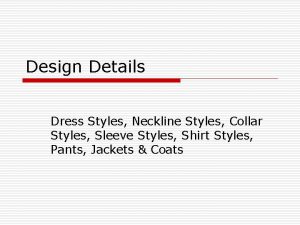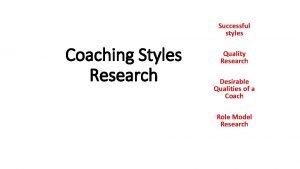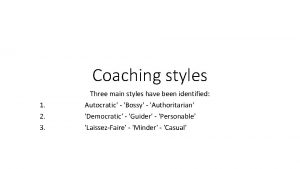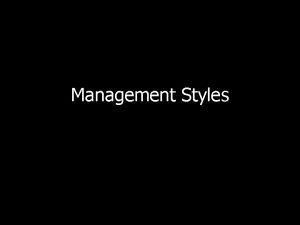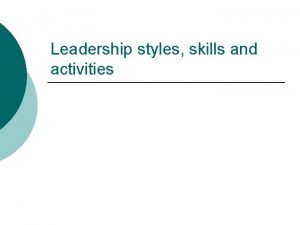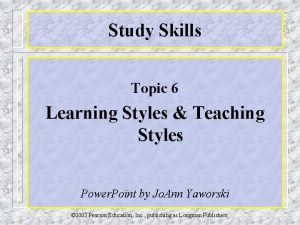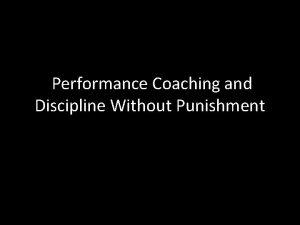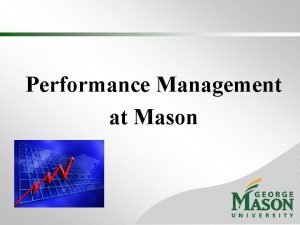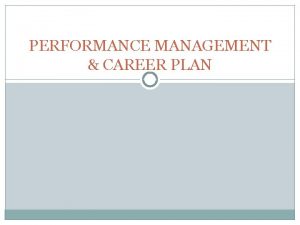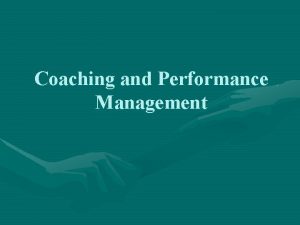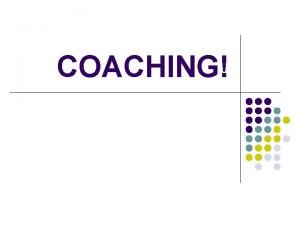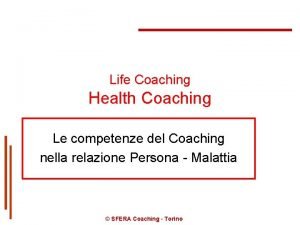Performance Management Skills Overview Coaching n Coaching Styles



































- Slides: 35

Performance Management Skills: Overview Coaching n Coaching Styles n Coaching Process n Performance Review Meetings n

Coaching: Definition (1) Helping relationship n Manager n • Interacts with employee and • Takes active role and interest in performance

Coaching: Definition (2) n Collaborative ongoing process • Directing employee behavior • Motivating employee behavior • Rewarding employee behavior • Concern with long-term performance

Understanding Successful Coaching Guiding Principles (1) n A good coaching relationship is essential: • Trusting and collaborative • Willing to listen in order to understand • Looking for positive aspects of the employee • Understanding that coaching is done with the employee, not to the employee

Understanding Successful Coaching Guiding Principles (2) The Employee is the Source and Director of change n The Employee is whole and unique n The Coach is the Facilitator of the Employee’s growth n

Major Coaching Functions: Give advice n Provide guidance n Provide support n Give confidence n Promote greater competence n

Key Coaching Behaviors Establish developmental objectives n Communicate effectively n Motivate employees n Document performance n Give feedback n Diagnose performance problems n Develop employees n

The Good Coach Questionnaire q q q Do you listen to your employees? Do you understand the individual needs of your employees? Do you encourage employees to express their feelings openly? Do you provide your employees with tangible and intangible support for development? Do your employees know your expectations about their performance? (continued on next slide)

The Good Coach Questionnaire (continued) Do you encourage open and honest discussions and problem solving? q Do you help your employees create action plans that will q Solve problems? q Create changes? q q Do you help your employees explore potential areas of growth and development?

Coaching Styles Task & Fact oriented People oriented More assertive Less assertive Driver Analyzer Persuader Amiable

Adaptive coaches use all styles according to employee needs: n n Sometimes providing direction Sometimes persuading Sometimes showing empathy Sometimes paying close attention to rules and established procedures

Coaching Process Set Developme ntal Goals Identify Development al Resources & Strategies Implement Strategies Give Feedback Observe and Document Developmental Behavior

Coaching Process: Steps covered in Chapter 8 Set Developmental Goals n Identify Resources and Strategies Needed to Implement Developmental Goals n

Coaching Process: Overview of remaining steps Observe and Document Developmental Behavior and Outcomes n Give Feedback n • Praise • Negative Feedback

Observe and Document Developmental Behavior and Outcomes Constraints: n n n Time Situation Activity

Organizational Activities to improve documentation of performance n n Good communication plan to get manager buy-in Training programs • Rater error training • Frame-of-reference training • Behavioral observation training • Self-leadership training

Reasons to document performance n n Minimize cognitive load Create trust Plan for the future Provide legal protection

Recommendations for Documentation n n n Be specific Use adjectives and adverbs sparingly Balance positives with negatives Focus on job-related information Be comprehensive Standardize procedures Describe observable behavior

Giving Feedback n Main purposes: • Help build confidence • Develop competence • Enhance involvement • Improve future performance

Potential costs of failing to provide feedback: n n n Employees are deprived of chance to improve their own performance Chronic poor performance Employees have inaccurate perceptions of how their performance is regarded by others

To be effective, feedback should: n n n n Be timely Be frequent Be specific Be verifiable Be consistent (over time and across employees) Be given privately Provide context and consequences (continued next slide)

To be effective, feedback should: (continued) n n n Provide description first, evaluation second Cover the continuum of performance Identify patterns Demonstrate confidence in employee Allow for both • Supervisor’s advice and • Idea generation by both n n Employee Supervisor

Guidelines for Giving Praise n n n Be sincere – only give praise when it is deserved Give praise about specific behaviors or results Take your time Be comfortable with act of praising Emphasize the positive

Giving Negative Feedback Managers avoid giving negative feedback due to: n Negative reactions and consequences n Negative experiences in the past n Playing “god” n Need for irrefutable and conclusive evidence

Negative feedback is most useful when it: n n n Identifies warning signs and performance problem is still manageable Clarifies unwanted behaviors and consequences Focuses on behaviors that can be changed Comes from a credible source Is supported by hard data

Feedback Sessions should always answer: (1) n How is your job going? n Do you have what you need to do your job? n Are you adequately trained? n Do you have the skills and tools you need to do your job?

Feedback Sessions should always answer: (2) n What can be done to improve? • Job • Product • Services n How can you better serve your customers? • Internal • External

Supervisory roles in managing performance n Judge • Evaluate performance • Allocate rewards n Coach • Help employee solve performance problems • Identify performance weaknesses • Design developmental plans

Performance Review Formal Meetings Possible types of formal meetings: 1. 2. 3. 4. 5. 6. System Inauguration Self-Appraisal Classical Performance Review Merit/Salary Review Developmental Plan Objective Setting

Steps to take before meeting: n n n Give at least 2 weeks notice Block sufficient time Arrange to meet in a private location without interruptions

Merged Performance Review Meeting Components 1. 2. 3. 4. 5. 6. 7. 8. 9. Explanation of meeting purpose Employee self-appraisal Supervisor & employee share rating and rationale Developmental discussion Employee summary Rewards discussion Follow-up meeting arrangement Approval and appeals process discussion Final recap

Possible defensive behaviors of employees n Fight response • • n Blaming others Staring at supervisor Raising voice Other aggressive responses Flight response • • • Looking/turning away Speaking softly Continually changing the subject • Quickly agreeing without basis • Other passive responses

To prevent/reduce defensive behaviors n n n Establish and maintain rapport Be empathetic Observe verbal and nonverbal cues Minimize threats Encourage participation

When defensiveness is unavoidable: Ø Ø Recognize it Allow its expression ØAccept employee’s feelings ØAsk for additional information and clarification (if appropriate) If situation becomes intolerable Ø Reschedule the meeting for a later time

Quick Review Coaching n Coaching Styles n Coaching Process n Performance Review Meetings n
 Analyzer coaching style
Analyzer coaching style Performance levels
Performance levels Performance appraisal process
Performance appraisal process High impact coaching skills
High impact coaching skills Star method interview
Star method interview Coaching for improved performance
Coaching for improved performance Network performance management functions
Network performance management functions Les 4 grands styles de management
Les 4 grands styles de management 4 styles de management
4 styles de management Fox conflict style
Fox conflict style Conflict styles
Conflict styles Content management system database
Content management system database Introduction to human resource management
Introduction to human resource management Management topics for project
Management topics for project Fitness management system
Fitness management system Real-time interaction management vendors
Real-time interaction management vendors Management overview
Management overview Peta konsep manajemen ekonomi
Peta konsep manajemen ekonomi Overview of financial management
Overview of financial management Multinational financial management meaning
Multinational financial management meaning Chapter 1 an overview of financial management
Chapter 1 an overview of financial management An overview of financial management
An overview of financial management Intrapersonal skills examples
Intrapersonal skills examples Define soft skills
Define soft skills Essential skills ontario
Essential skills ontario Performance skills list
Performance skills list Jcids manual 2018
Jcids manual 2018 Coaching careers and talent management
Coaching careers and talent management Scientific management
Scientific management Top management middle management first line management
Top management middle management first line management Basic concepts of management
Basic concepts of management Life skills stress management
Life skills stress management 3 management skills
3 management skills Middle level management
Middle level management 3 management skills
3 management skills Anger cues
Anger cues





